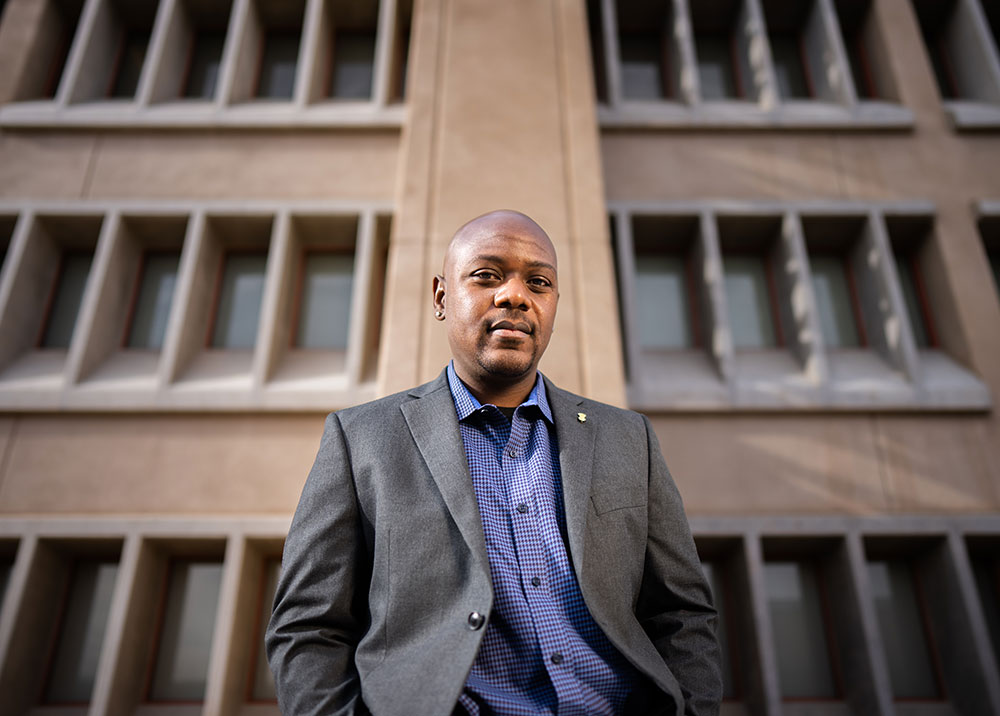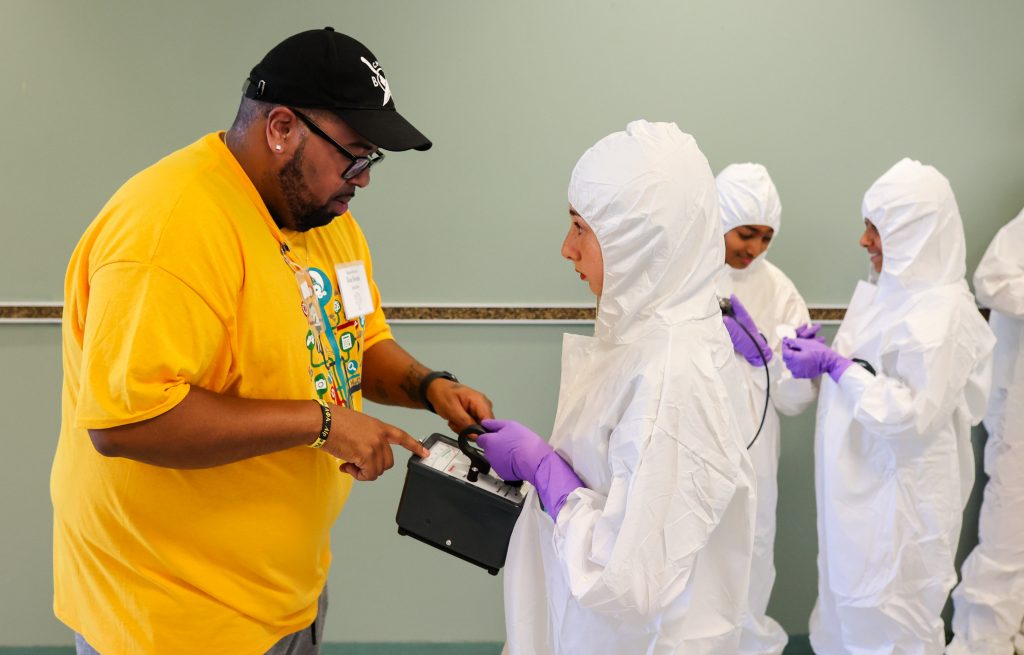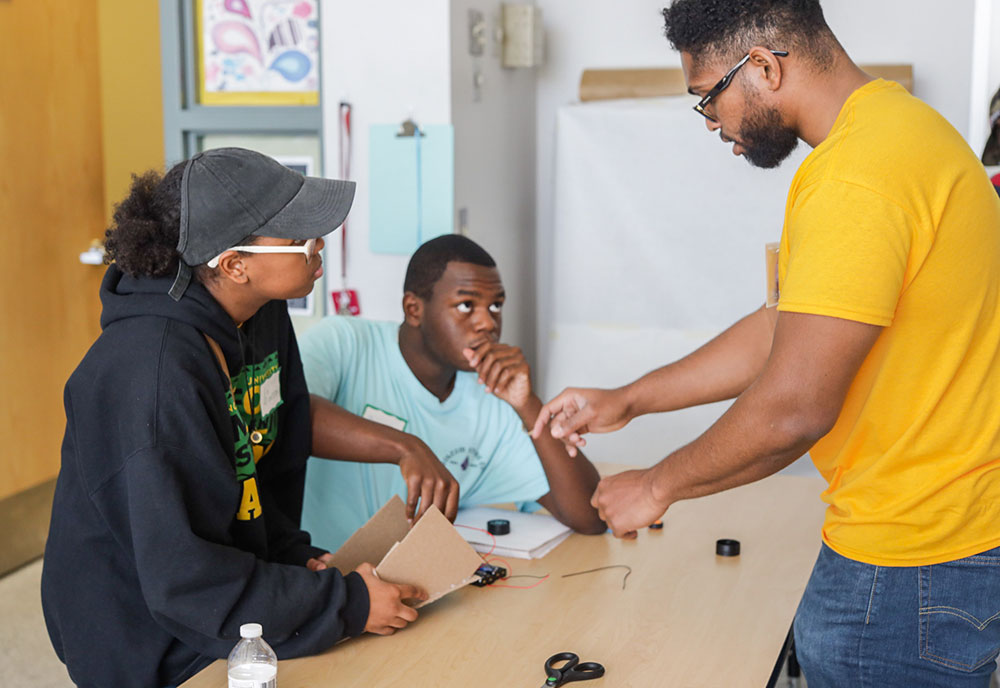Building scientists, engineers and technologists of the future

The Hands-on, Minds-on Technology program, better known as HMTech, continues to bring together Sandians and Black students to inspire futures in STEM. In its nearly 50 years of existence, in both official and unofficial forms, HMTech has connected hundreds of minority students to the world of STEM, some of whom have gone on to have successful careers at Sandia.
The annual program teams experts from Sandia with students to give them a hands-on look at disciplines such as computing, electronics, physics, web-page design, forensic analysis, drafting, earth and air pollution chemistry, engineering, environmental science, rocket design, machining, physical science, civil engineering, robotics, geology and sports medicine.
This year’s program was held over three Saturdays in June at Albuquerque High School and included 68 students from 36 middle and high schools across the metro, as well as some homeschoolers. The program culminated with a special message from Sandia Deputy Labs Director David Gibson, who served as a guest speaker.
“STEM can be your pathway to a fulfilling career,” David said. “Mine has been amazing. I started as a Sandia intern in 1998, my senior year at University of New Mexico. Diverse opportunities led me to meaningful work with far-reaching impact. My colleagues are smart, caring people who solve tough problems and make our world a safer place. Study, learn, succeed in college and doors will open for you.”

A long history
HMTech was officially founded in 1986 by Roberta Ingram and Patricia Salisbury after becoming concerned that Black students were being left out of educational programs being launched in the community. As a result, they created an after-school computer class that consisted of 30 students. The community response was so overwhelming, the team added more classes. In the early ’90s, HMTech became a Sandia-sponsored program.
However, long before HMTech was an official group, Sandians were helping inspire minority youth. In the late 1970s, a small group of Black employees formed a student outreach program known as the Saturday Science Academy. It was a grassroots effort staffed entirely by Sandia volunteers. It focused on exposing Black students to science and engineering to help increase the number who pursued collegiate and professional careers in STEM. These pioneers recognized that if reached at an early age, they could help youth in their community overcome a lack of educational foundation, exposure to career opportunities, confidence and family support, which they recognized as prevalent problems. It was the basis for the HMTech program.
An HMTech success story
One of the success stories from HMTech is that of Sean Harris, manager of cyber systems research at Sandia. Sean, a 19-year employee, was born and raised in Albuquerque, and is a product of the program.
“It wasn’t uncommon for me to be the only Black kid in the whole school; I was definitely the only one in my class. I kind of thought it was normal through middle and high school,” he said. Then, one year, Sean’s parents took him to the Saturday Science Academy. “I was kind of shocked. I saw other Black kids there. I told myself ‘Hey, we are here.’ It was cool,” he said.
Years later, after HMTech was officially formed, Sean became a regular participant. “I remember working on a robotic circuit board. It was my first exposure to the internal components of computing, including the chips, circuits and wires. We were soldering things,” he said.
However, something else stood out in his mind even more. “I remember going to HMTech and thinking these students and instructors looked like me. It was the first time seeing Black people in the STEM field, teaching in this technical arena. It gave me the thought that if they were doing this, I could do this too.” It was the start of Sean’s higher education and a successful career.
Paying it forward
Sean has made it his mission to pay it forward. He is now the co-chair of the Black Leadership Committee, which operates the HMTech program, and he spends time mentoring Black youth, Sandia interns and early career Sandians.

Sean is the nephew of HMTech program co-founder Patricia Salisbury. He recognizes that many Black youth don’t have that same support or connection to the world of STEM. The key is catching students early to make sure they have the fundamentals so they can be prepared, he said. Sean spends his time mentoring students by giving them career, financial and professional development advice.
He is motivated by past experiences, like a memory of his only Black professor. “I would try not to make eye contact with him because he always called on me. I came to realize he was invested in my success, and I wasn’t just a student ID number,” he said.
Another driver, however, was a not-so-pleasant experience. “I was in high school and was excited because I was admitted provisionally to University of New Mexico. I went to talk to the guidance counselor and all I remember is her telling me, ‘You know you don’t have to go to college; there are other avenues you can take.’ She was raining on my parade,” Sean remembered. Many of his career accomplishments were sparked by her words, and the motto he now lives by: “Never let others tell you what you can’t do.”
Sean hopes his words and actions will make a lasting impact as well. “I want to make sure I hold the door open for those who come behind me because if it weren’t for those who came before me and held the door open for me, I wouldn’t be where I am today,” he said.